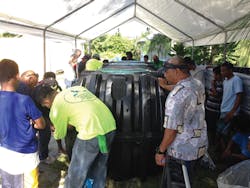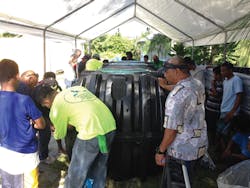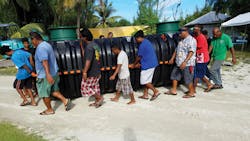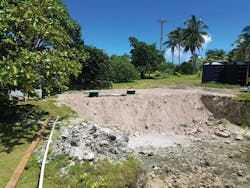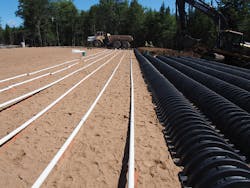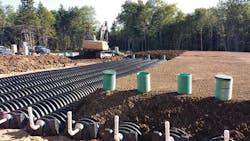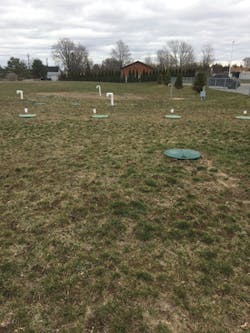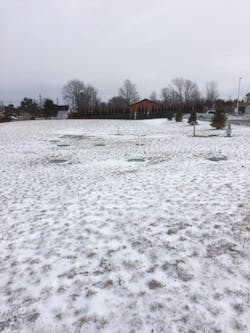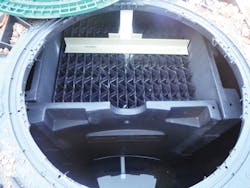Decentralized Wastewater Treatment
Preserving Public Health for Rural and Remote Communities
By Dennis F. Hallahan
Previously underdeveloped countries are experiencing severe environmental challenges and, in some cases, an influx of wealth that is raising living standards. Both situations are placing a demand on nonexistent or limited infrastructure for water and wastewater treatment. With running water becoming a norm in homes and businesses, the need for disposal of wastewater is paramount as is the need for wastewater treatment strategies that can preserve public health at a low cost.
Three Wastewater Treatment Questions for Communities
With the number of potential options, it can be difficult for community leaders and residents to determine the most beneficial approach to take. Answering a few basic questions can help determine the best solution for each individual need.
1. What is the current wastewater treatment challenge(s)?
Officials and residents need to understand the current problems and shortcomings of the wastewater treatment system(s) in the community, including antiquated or nonexistent septic systems, leaking sewers, an over-capacity system, sewage overflows, underfunding, watershed issues, groundwater pollution, nutrient overloading to sensitive areas, and/or regulatory non-compliance. Citizens need to be informed about the options and costs of proposed solutions and the local codes governing the selection.
IWT staff trained Senator Kabua and his staff and local townspeople to assemble the Infiltrator IM-Series plastic tanks on Ebeye Island.
2. How do the projections for community growth impact anticipated wastewater treatment needs?
Centralized sewers offer the possibility for large-scale, rapid commercial and residential growth, but many communities want to avoid that to retain historic and community character or are unable to raise the funds for large infrastructure improvements. Decentralized treatment enables a community to focus on specific and most critical treatment needs and allows for smaller design flows and disposal areas. This places the financial burden on specific properties rather than on the whole community. Communities and individuals should consult an expert to make the best choice without being bias-directed toward only one of the treatment options.
Ebeye Island townspeople carry 5,678-liter lightweight, plastic Infiltrator IM-Series Tank.
3. What are the true costs?
Cost savings can be a significant advantage with decentralized treatment. However, regardless of the selected approach, design, permitting, legal, land purchase, and construction costs are all short-term cost factors. Long-term costs include operation and maintenance (O&M), licensed operators, billing structure, district vehicles (specialized service trucks), and specialized equipment.
Advanced wastewater treatment products such as fixed-film bioreactors, modular products such as chambers and geosynthetic aggregate bundles, and lightweight, high-strength plastic septic tanks offer individuals and communities effective and efficient options. In these cases, there is also no concrete used in the system, which benefits the environment along with providing ease of installation.
Tanks were installed at high tide so they would not be impacted by the high water table.
The Decentralized Choice
The decentralized model collects, treats, and then discharges to the subsurface at, or very close to, the point of origin, restoring the original water resource to the local aquifer at a much lower energy cost. With rapid aquifer depletion and dropping water tables, minimizing the controllable impacts to the water cycle is critical for sustainability. Where no wastewater treatment exists or the systems are outdated and under capacity, traditional and advanced decentralized treatment system possibilities can protect local waterways and water supplies, upgrade outdated systems to reduce nitrogen loading, and improve overall wastewater management for the community.
Many communities are turning to a combination of approaches to solve their wastewater treatment challenges. These systems often provide decentralized collection that moves to a centralized treatment facility then to a large disposal field. Most are centrally managed, including publicly- and privately-owned community systems, and staffed with trained personnel like centralized systems.
The watertight Septic Tank Effluent Pump (STEP) pressurized effluent sewer collection system delivers primary effluent via small-diameter mainlines to secondary wastewater treatment plant.
Decentralized Wastewater Treatment
Applications and Products
Designing a small-scale, advanced treatment train prior to dispersal of the effluent into the native soil can decrease both the absorption area and depth to limiting layers that are required for adequate treatment and increase the volume of groundwater recharge. Decentralized systems as large as 4 million liters can now be developed for commercial and industrial sites, decreasing the hydraulic and nutrient stress placed on centralized wastewater treatment plants.
The new generation of onsite wastewater treatment products enhance design options and system performance, ease installation, and reduce management dilemmas.
Tanks
The need for compact systems for small lots and for systems in environmentally sensitive areas is a catalyst for tank innovation. On difficult or remote sites, the new generation of plastic tanks enable shallow, low-profile installation to leverage available space. Advances in manufacturing processes for plastic tanks have improved this option over the tanks of the past. Significant manufacturing advances have increased tank strength and durability and enabled lightweight tanks of more than 5,000 liters to be manufactured that can also be shipped in “halves” to remote sites.
The secondary wastewater treatment plant is followed by dosing tanks, and then an Infiltrator Quick4 Plus Standard Chamber soil dispersal system.
Project Example: Kwajalein Atoll, Micronesia
Aging, ineffective cesspools, cost concerns, and a need to prevent effluent nitrogen from damaging the sensitive lagoon and open ocean surrounding the Kwajalein atoll spurred local officials and residents, led by Senator Mike Kabua, to seek a new approach.
The project, designed by International Wastewater Technologies (IWT), was challenging due to the remote atoll location and the shallow six-foot water table. The first-phase solution was to contain wastewater from each individual dwelling that could later be pumped and transported to a centralized treatment facility on neighboring Ebeye Island. IWT arranged the delivery of four 5,678-liter Infiltrator IM-1530 tanks 4,130 kilometers by boat from Honolulu to Ebeye Island and finally to the Kwajalein atoll. A subsequent delivery of three 3,785-liter Infiltrator IM-1040 tanks and alarm panels was completed, with each delivery taking two weeks to a month. The plastic two-piece tanks offered the ideal solution as they ship nested to be assembled on site upon arrival.
Assuming there would be no equipment or tools to complete the tank and tank alarm assembly and installation, IWT packaged and shipped the tanks, control panel conduit, alarm float switches, and all materials for future O&M to the atoll.
The tanks traveled first to the west coast of the United States, then by boat to Hawaii and on to Ebeye Island, part of the Kwajalein atoll. They were trucked via causeway to Lojjairok Island. Assembly instruction was provided by IWT to the senator, his assistant, and the townspeople. Future systems under consideration include wastewater packaged plants and expanded aerobic technology.
Ontario school’s FFBR system in summer (top) and winter (bottom).
Chambers
Chambers are highly adaptable and effective for specialized system designs and treatment needs and are commonly used in sand filters, mound systems, evapotranspiration beds, community (cluster) systems, constructed wetlands, large-scale wastewater treatment plants, with pretreatment devices, and even on toxic waste remediation sites.
Project Example: Nova Scotia, Canada
Forest Lakes Country Club is a four-season resort community outside Halifax with 2,700 residential units, a championship golf course, and a Village Centre. No centralized municipal sewer or wastewater treatment infrastructure was available, and a key design consideration was that it work reliably 24/7, 365 days a year in the northern, maritime climate typical of Nova Scotia. Each neighborhood utilizes a decentralized wastewater collection, treatment, and disposal system. One neighborhood system serves 50 homes and has a peak flow design of 51,200 liters per day. The watertight Septic Tank Effluent Pump (STEP) pressurized effluent sewer collection system delivers primary effluent via small-diameter mainlines to a secondary wastewater treatment plant, followed by dosing tanks, and an Infiltrator Quick4™ Plus Standard Chamber soil dispersal system.
Advanced Wastewater Treatment Units
Advanced Wastewater Treatment Units (ATUs) are favored in areas with poor soils, shallow vertical separation distances to limiting conditions, horizontal setback restrictions, tight lots, high-strength wastewater, and nitrogen removal needs. These units are most often installed inside a plastic tank.
Project Example: Ontario, Canada
A fixed-film bioreactor (FFBR) system at an Ontario, Canada, school has a flow rate of 4,500 gallons per day, influent strength of 300 mg/L BOD, 300 mg/L TSS, and 60-75 mg/L of total nitrogen. Stringent nitrogen effluent requirements dictated primary treatment, first stage nitrification, second stage denitrification, and a polishing stage to remove any excess carbon.
Operations test data demonstrated that the primary effluent was nearly completely nitrifying the available ammonia in the influent. The first stage ECOPOD FFBR unit, equipped with an alkalinity feed, reduced that total nitrogen load by a minimum of 53 percent. With recirculation, the nitrogen is reduced to the permit level of less than 20 mg/L. The ECOPOD reactor was installed with a carbon source dose system into the dilution zone to feed the denitrification process. The final ECOPOD unit polishes the final effluent, removing any carbon not utilized in the denitrification process prior to effluent discharge.
After some fine-tuning of the recirculation rates and feed rates to accommodate the variety of influent flows at this site, the system has a consistent effluent output of less than 10 mg/L total nitrogen.
The final ECOPOD unit polishes the final effluent, removing any carbon not utilized in the denitrification process prior to effluent discharge.
Conclusion
Decentralized systems offer many benefits for rural or remote residential or community applications and the best approach varies from case to case. Community leaders and residents need to define the community’s environmental challenges and anticipated growth in order to make the best wastewater treatment choice. Local codes, proximity to water bodies, and anticipated daily flows are additional key factors for individual, commercial, or community systems. In most cases, the decentralized approach can offer lower cost, high performance, and versatility when compared to a centralized option. WW
About the Author: Dennis F. Hallahan, P.E., has over 30 years of experience with onsite wastewater treatment system design and construction. As the technical director at Infiltrator Water Technologies, he is responsible for technology transfer between Infiltrator and the regulatory and design communities and consults on product research and testing for universities and private consultants. Hallahan received his M.S. in civil engineering from the University of Connecticut and his B.S. in civil engineering from the University of Vermont. He is a registered professional engineer in Connecticut and holds several patents for onsite wastewater products. He can be reached at [email protected].
Circle No. 244 on Reader Service Card
